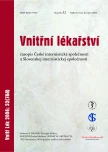Gastroduodenal complications associated with non-steroidal anti-inflammatory drugs in Slovak Republic: results of one-year prospective study
Authors:
I. Rybár 1; M. Hlista 2; P. Masaryk 3; J. Rovenský 1,3; R. Hyrdel 4; M. Kriška 5
Authors‘ workplace:
Katedra reumatológie Fakulty zdravotníctva a špecializačných štúdií Slovenskej zdravotníckej univerzity, Bratislava, Slovenská republika, vedúci prof. MUDr. Jozef Rovenský, DrSc., FRCP
1; Interné oddelenie NsP, Trenčín, Slovenská republika, prednosta prim. MUDr. Oto Herman
2; Národný ústav reumatických chorôb, Piešťany, riaditeľ prof. MUDr. Jozef Rovenský, DrSc., FRCP
3; II. interná klinika Jeseniovej lekárskej fakulty UK a Centrum pre liečbu rezistentných peptických vredov, Martin, Slovenská republika, prednosta prof. MUDr. Rudolf Hyrdel, CSc.
4; Farmakologický ústav Lekárskej fakulty UK, Bratislava, Slovenská republika, vedúci prof. MUDr. Milan Kriška, DrSc.
5
Published in:
Vnitř Lék 2006; 52(7-8): 673-676
Category:
130th Internal Medicine Day - Rheumatology in clinical practice
Overview
The aim of the one-year prospective study was to estimate the prevalence of non-steroidal anti-inflammatory drugs using in patients with symptomatic gastroduodenal ulcers, the upper gastrointestinal bleeding and perforation (PUB - perforation, ulcer, bleeding). Among of 326 patients with PUB, prevalence of non-steroidal anti-inflammatory drugs using was 60 %. In the group of 194 patients with non-steroidal antiinflammatory drugs induced PUB, 49 % patients took aspirin, 38 % non-aspirin non-steroidal anti-inflammatory drugs and 13 % their combination. Low dosing aspirin (dialy dosis ≤ 200 mg) was associated with PUB in 21 % of patients. Age higher than 60 years and women had statisticaly signiticant higher prevalence of non-steroidal anti-inflammatory drugs induced PUB.
Key words:
non-steroidal anti-inflammatory drugs - peptic ulcer - gastrointestinal bleeding - gastropathy - rheumatic diseases - epidemiology
Sources
1. Singh G. Recent consideration in nonsteroidal anti-inflammatory drug gastropathy. Am J Med 1998; 105(Suppl 1): 31S-38S.
2. Garcia Rodriguez LA, Jick H. Risk of upper gastrointestinal bleeding and peroration associated with individual non-steroidal anti-inflammatory drugs. Lancet 1994; 343: 769-772.
3. Forrest JAH, Finlayson NDC, Shaerman DJC. Endoscopy in gastrointestinal bleeding. Lancet 1974; ii: 394-397.
4. Bures J. Gastric and duodenal ulcers - etiopathogenesis, diagnosis and therapy at the milestone of the 20th century. Vnitř Lék 2004; 50(Suppl 1): S91-S93.
5. Kunovská M, Dite P, Lata J et al. Helicobacter pylori negative gastroduodenal lesions in subjects treated with nonsteroidal anti-inflammatory drugs. Vnitř Lék 2000; 46: 384-386.
6. Fialová P, Vlček J. The role of anti-ulcerative drugs in treatment and prevention of gastropathies induced by nonsteroidal anti-inflammatory drugs. Vnitř Lék 2004; 50: 858-866.
7. Lukáš M, Chalupná P. Retrospektivní analýza vlivu nesteroidních antirevmatik na masivní krvácaní do horní části trávici trubice. Prakt Lék 2003; 83: 13-17.
8. Shostak NA, Riabkova AA, Saveljev VS et al. Gastrointestinal hemorrhages as complications of gastropathies associated with intake of nonsteroidal anti-inflammatory drugs. Ter Arkh 2003; 75: 70-73.
9. Wilcox CM, Shalek KA, Cotsonis G. Striking prevalence of over-the-counter nonsteroidal anti-inflammatory drug use in patients with upper gastrointestinal haemorrhage. Arch Intern Med 1994; 154: 42-46.
10. Gutthann SP, Garcia Rodriguez LA, Raiford DS. Individual nonsteroidal anti-inflammatory drugs and other risk factors for upper gastrointestinal bleeding and perforation. Epidemiology 1997; 8: 18-24.
Labels
Diabetology Endocrinology Internal medicineArticle was published in
Internal Medicine

2006 Issue 7-8
Most read in this issue
- Nonsteroidal antiinflammatory drugs and the kidney
- Systemic lupus erythematodes
- Ankylosing spondylitis – the current situation and new therapeutic options
- Antiphospholipid syndrome
